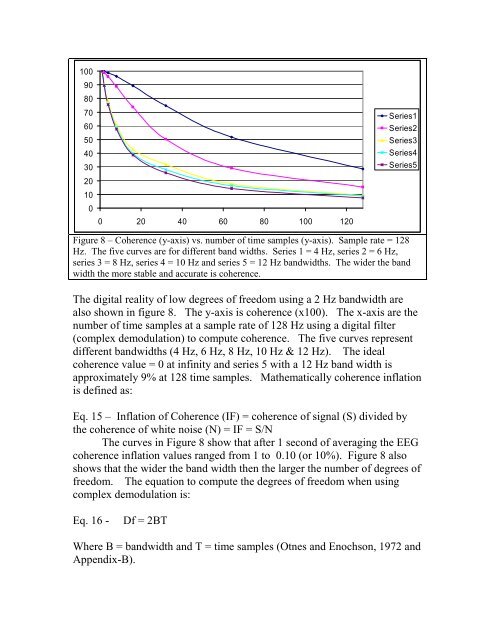EEG and Brain Connectivity: A Tutorial - Bio-Medical Instruments, Inc.
EEG and Brain Connectivity: A Tutorial - Bio-Medical Instruments, Inc.
EEG and Brain Connectivity: A Tutorial - Bio-Medical Instruments, Inc.
You also want an ePaper? Increase the reach of your titles
YUMPU automatically turns print PDFs into web optimized ePapers that Google loves.
100<br />
90<br />
80<br />
70<br />
60<br />
50<br />
40<br />
30<br />
20<br />
10<br />
0<br />
0 20 40 60 80 100 120<br />
Series1<br />
Series2<br />
Series3<br />
Series4<br />
Series5<br />
Figure 8 – Coherence (y-axis) vs. number of time samples (y-axis). Sample rate = 128<br />
Hz. The five curves are for different b<strong>and</strong> widths. Series 1 = 4 Hz, series 2 = 6 Hz,<br />
series 3 = 8 Hz, series 4 = 10 Hz <strong>and</strong> series 5 = 12 Hz b<strong>and</strong>widths. The wider the b<strong>and</strong><br />
width the more stable <strong>and</strong> accurate is coherence.<br />
The digital reality of low degrees of freedom using a 2 Hz b<strong>and</strong>width are<br />
also shown in figure 8. The y-axis is coherence (x100). The x-axis are the<br />
number of time samples at a sample rate of 128 Hz using a digital filter<br />
(complex demodulation) to compute coherence. The five curves represent<br />
different b<strong>and</strong>widths (4 Hz, 6 Hz, 8 Hz, 10 Hz & 12 Hz). The ideal<br />
coherence value = 0 at infinity <strong>and</strong> series 5 with a 12 Hz b<strong>and</strong> width is<br />
approximately 9% at 128 time samples. Mathematically coherence inflation<br />
is defined as:<br />
Eq. 15 – Inflation of Coherence (IF) = coherence of signal (S) divided by<br />
the coherence of white noise (N) = IF = S/N<br />
The curves in Figure 8 show that after 1 second of averaging the <strong>EEG</strong><br />
coherence inflation values ranged from 1 to 0.10 (or 10%). Figure 8 also<br />
shows that the wider the b<strong>and</strong> width then the larger the number of degrees of<br />
freedom. The equation to compute the degrees of freedom when using<br />
complex demodulation is:<br />
Eq. 16 -<br />
Df = 2BT<br />
Where B = b<strong>and</strong>width <strong>and</strong> T = time samples (Otnes <strong>and</strong> Enochson, 1972 <strong>and</strong><br />
Appendix-B).
















